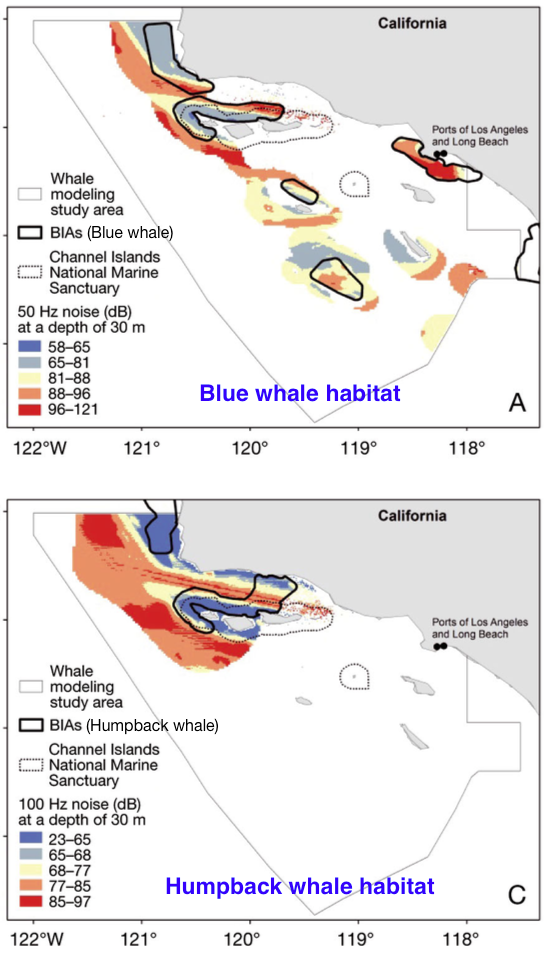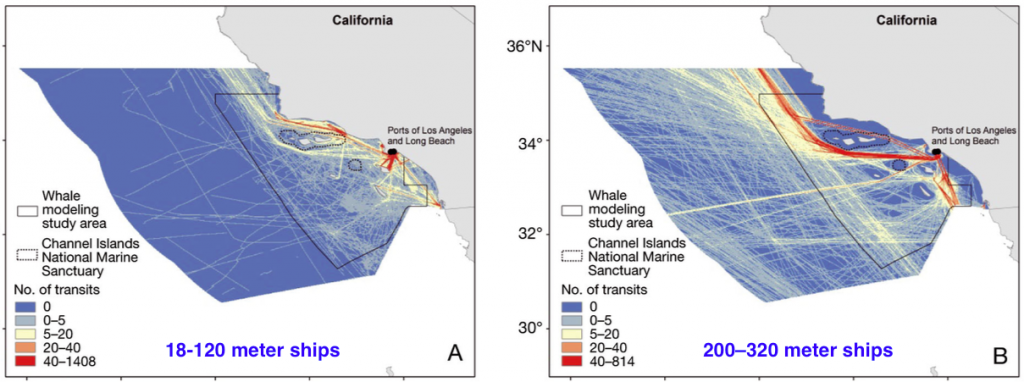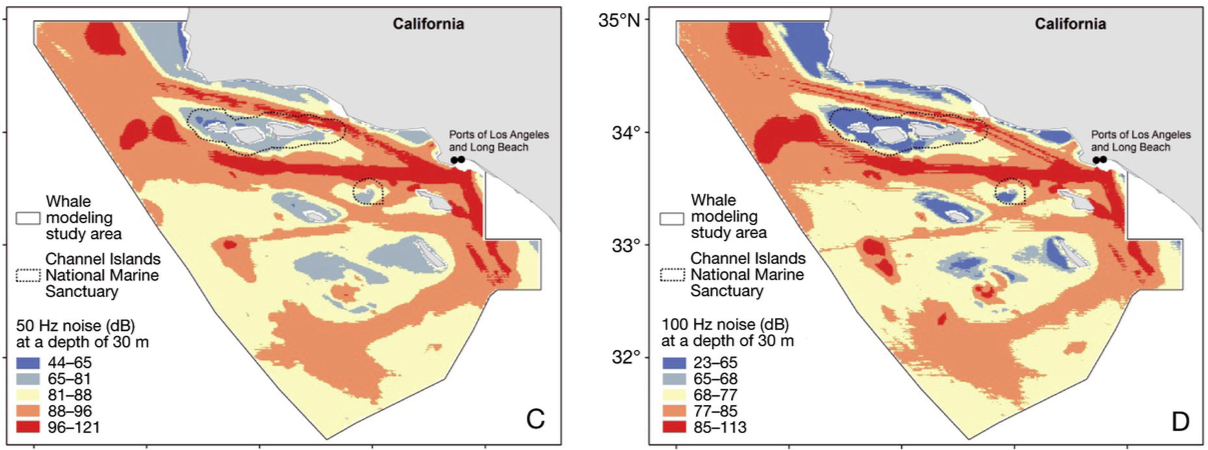AEI lay summary of
Redfern JV, Hatch LT, Caldow C, DeAngelis ML and others (2017) Assessing the risk of chronic shipping noise to baleen whales off Southern California, USA. Endang Species Res 32:153-167. https://doi.org/10.3354/esr00797 (open access)
A paper published earlier this year (on my birthday; what a nice present!) takes a close look at shipping noise levels along the Santa Barbara/Los Angeles coast, with particular attention to key habitat areas for several whale species. This region of offshore waters includes crucial feeding zones on the edge of the continental shelf, as well as the Channel Islands National Marine Sanctuary; meanwhile, some of the shipping traffic headed into the port of Long Beach (near LA) passes between the Sanctuary and the coastline.
The pictures generated by the authors surely qualify for the thousand-words designation, so I’ll let these key graphics tell most of the story—you can click any image to see a larger version. First up, here’s the number of ship transits occurring in these waters over five months (August to November 2009):
Next, here’s how the accumulated noise of all these ships translates into sound levels. The researchers modeled the sound levels at two different frequencies; this is because the 50Hz band is especially important to blue and fin whales, while the 100Hz band is most important to humpback whales. Note that at both frequencies, there are some areas that remain relatively protected from the worst of the shipping noise.
Finally, the researchers look at how the shipping noise maps look in the areas that are known whale habitat.
 The large splotches of color on these maps represent areas with relatively higher whale densities, while the bold-outlined areas are designated Biologically Important Areas (BIAs) for each species. As you can see, much of the BIAs for both Blue whales and Humpback whales remain relatively modestly affected. However, the near-shore shipping lane clearly creates elevated sound levels in some of these key areas, and generates an acoustic hot spot between the northern and southern BIAs for both species. In addition, the primary shipping lanes (passing farther offshore, around the Channel Islands) create severely elevated sound levels in broad expanses of heavily-used habitat, including a Blue whale BIA that is, unfortunately, at the doorstep of the Port of Long Beach.
The large splotches of color on these maps represent areas with relatively higher whale densities, while the bold-outlined areas are designated Biologically Important Areas (BIAs) for each species. As you can see, much of the BIAs for both Blue whales and Humpback whales remain relatively modestly affected. However, the near-shore shipping lane clearly creates elevated sound levels in some of these key areas, and generates an acoustic hot spot between the northern and southern BIAs for both species. In addition, the primary shipping lanes (passing farther offshore, around the Channel Islands) create severely elevated sound levels in broad expanses of heavily-used habitat, including a Blue whale BIA that is, unfortunately, at the doorstep of the Port of Long Beach.
While this paper does not include the next step of the maps, which would follow on similar work off the BC coast to highlight conservation “opportunity sites” with high population-use and low noise, or “risk areas” with high noise and high use, the authors do dig into these issues in their narrative, making several recommendations that bear serious consideration.
For starters, the authors suggest that US could work with the International Maritime Organization (IMO) to designate some sections in the BIAs as an Particularly Sensitive Sea Area (PSSA), “and implementing management measures that require or recommend that ships operate in a manner that reduces noise.”
At least some of the current low sound level in the Channel Islands National Marine Sanctuary is thanks to existing IMO Area to be Avoided (ATBA) designations there (the Sanctuary itself does not regulate noise); the IMO’s ATBA designation, designed to reduce grounding and pollution risks, has effectively kept ships out of much of the area. It appears from the transit maps above that the near-shore shipping traffic is mostly smaller vessels, with a few of the bigger ones taking that route as well. Speed reductions, slight adjustments to the current shipping lane, or moving the larger ships into the shipping lanes south of the islands all may reduce the noise footprint.
Meanwhile, there are some areas in which could be proactively protected to maintain current low noise levels:
Humpback and blue whales BIAs in coastal waters off Point Conception contained some of the remaining quiet areas in Southern California waters. Areas that support feeding and breeding for these populations and that are currently quieter, relative to regional levels, could be designated as ATBA to ensure they remain free of high levels of shipping traffic.
Among the further research that the authors encourage is the application of new “communication space” metrics to the whale populations in this region, multi-factor studies that look at noise alongside other variables that contribute to foraging and mating success, and research into stress hormone levels in noisy and quieter areas.


